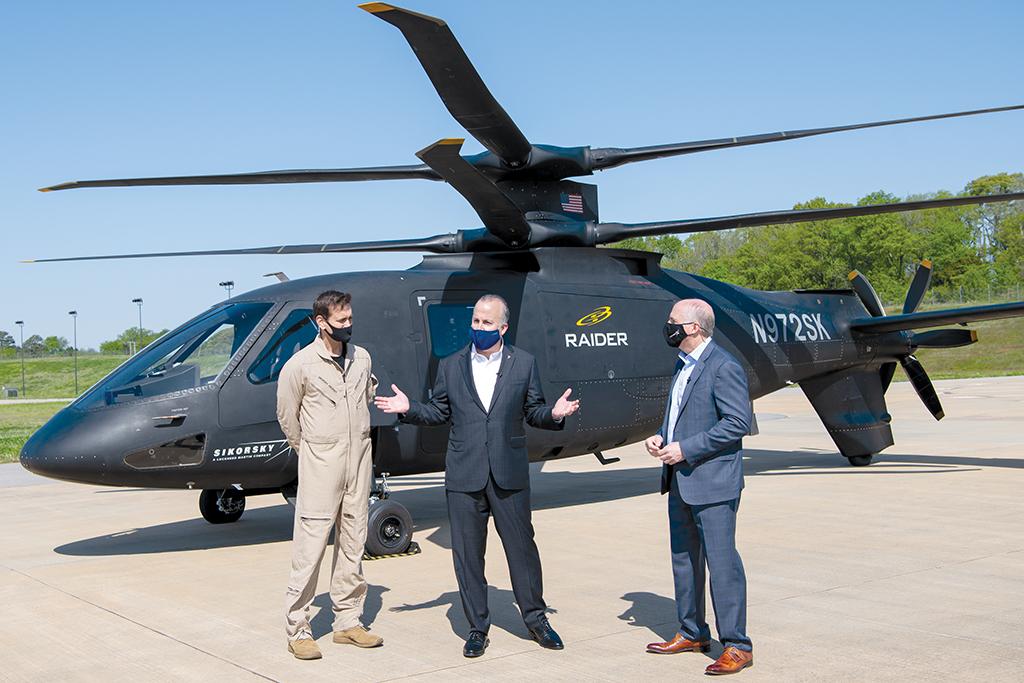
A 34-year veteran of Lockheed but new to the rotorcraft business, Paul Lemmo became president of Sikorsky Aircraft in January 2021. He outlined his priorities in an interview with Executive Editor for Technology
Graham Warwick and Pentagon Editor Lee Hudson: First, transitioning the U.S. Marine Corps CH-53K heavy-lift helicopter and U.S. Air Force HH-60W Combat Rescue Helicopter (CRH) programs from development into production, through initial operational test and evaluation and to initial operational capability; and second, winning two Future Vertical Lift (FVL) competitions—the U.S. Army’s Future Long-Range Assault Aircraft (FLRAA) with the Sikorsky/Boeing Defiant X and the Future Attack Reconnaissance Aircraft (FARA) with its own Raider X.
What other priorities have you identified? No. 3 is continuing the digital journey that we’ve had over the last 5-10 years. And this is really Lockheed Martin’s journey over the last 10 years-—making sure that we are digital from design through sustainment of our products.
And Sikorsky has come a long way. I would say we’re one of the leaders within Lockheed Martin in already having implemented quite a bit of the digital thread. The CH-53K and CRH were born digital and have carried that from design into production.
So if you saw how we’re producing those two aircraft compared to a Black Hawk, you’d see a big difference. There’s no paper on the floor. Even the tools are digital. There’s a lot of augmented reality we can use on the factory floor to help operators know how much torque they’re applying to a bolt, or aligning and positioning gears and main rotors.
And then in sustainment, the same thing. Now we have a digital twin that can carry through to sustainment and allow us to more efficiently sustain the aircraft—when we need parts and when things are reaching their life limit.
We see Future Vertical Lift [FVL] as taking that digital thread to the next level in instantiation. FVL programs will be completely model-based system engineering. They already have their digital twins, as we’ve been developing both the Defiant X and Raider X, and those will carry throughout the programs.

Are you seeing any early benefits from model-based digital engineering? The CH-53K exhaust gas reingestion issue was a great example of having a digital model and being able to use that to solve the problem. We might still be talking about that if it were not for the modeling we did that gave us the answer on how to fix it. And when we fixed it, lo and behold, we said: “Yeah, the models are pretty correct.”
How is this digital thread helping on both FLRAA and FARA? Raider X is progressing well. We are over 50% complete on the build down at our West Palm Beach facility, and we expect to fly toward the end of 2022, as planned. I want to go back to the digital thread because both the Defiant and Raider X are being done in this digital environment. We’re building Raider X in about half the time of a normal helicopter. We were already cutting metal before we had the tooling completely finished. So there’s a lot being done because of the digital thread.
And the SB-1 Defiant demonstrator, how is that going? Defiant has been flying. In fact, we did a number of speed tests over the last several weeks and exceeded the minimum 230 kt. requirement in level flight. We’re pushing higher in speeds as we expand that envelope.
The FVL customer must also embrace digital engineering. Are they? I would say it’s a journey for both sides—-industry and government—because it is new for government to be this heavily involved in a model-based design at this stage of the program. But I think it’s been working very well, and the exchange back and forth has been very informative.
And they’re open to doing things differently. They understand that this program requires acceleration. They need this capability faster, so things are going to be done differently. We’re going to do a lot more testing in the digital environment than we were doing physically, and they have to be right there with us. We can’t just decide that on our own. But what I’m seeing is the willingness to lean forward and take advantage of the digital thread.







Comments